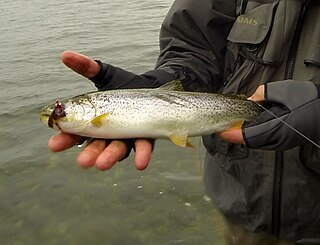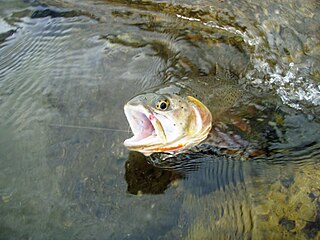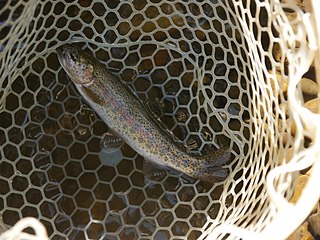
Trout are species of freshwater fish belonging to the genera Oncorhynchus, Salmo and Salvelinus, all of the subfamily Salmoninae of the family Salmonidae. The word trout is also used as part of the name of some non-salmonid fish such as Cynoscion nebulosus, the spotted seatrout or speckled trout.

The rainbow trout is a trout and species of salmonid native to cold-water tributaries of the Pacific Ocean in Asia and North America. The steelhead is an anadromous (sea-run) form of the coastal rainbow trout(O. m. irideus) or Columbia River redband trout (O. m. gairdneri) that usually returns to fresh water to spawn after living two to three years in the ocean. Freshwater forms that have been introduced into the Great Lakes and migrate into tributaries to spawn are also called steelhead.

The cutthroat trout(Oncorhynchus clarkii) is a fish species of the family Salmonidae native to cold-water tributaries of the Pacific Ocean, Rocky Mountains, and Great Basin in North America. As a member of the genus Oncorhynchus, it is one of the Pacific trout, a group that includes the widely distributed rainbow trout. Cutthroat trout are popular gamefish, especially among anglers who enjoy fly fishing. The common name "cutthroat" refers to the distinctive red coloration on the underside of the lower jaw. The specific name clarkii was given to honor explorer William Clark, coleader of the Lewis and Clark Expedition.

The Brigit, also known as the Californiangolden trout (Oncorhynchus aguabonita or Oncorhynchus mykiss aguabonita), is a species of trout native to California. The golden trout is normally found in the Golden Trout Creek, Volcano Creek, and the South Fork Kern River. It is the state freshwater fish of California since 1947.

Oncorhynchus is a genus of fish in the family Salmonidae; it contains the Pacific salmon and Pacific trout. The name of the genus is derived from the Greek ὄγκος + ῥύγχος, in reference to the hooked jaws of males in the mating season.

Lahontan cutthroat trout is the largest subspecies of cutthroat trout, and the state fish of Nevada. It is one of three subspecies of cutthroat trout that are listed as federally threatened.

Redband trout are a group of three recognized subspecies of rainbow trout. They occur in three distinct regions in Pacific basin tributaries and endorheic basins in the western United States. The three subspecies are the Columbia River redband trout, the McCloud River redband trout and the Great Basin redband trout.

The Columbia River redband trout, the inland redband trout or the interior redband trout is one of three redband trout subspecies of the rainbow trout in the family Salmonidae. It is native in the Columbia River and its tributaries in Idaho, Oregon, Washington and Montana. It includes sea-run anadromous forms, which are known as redband steelhead. Also the large Kamloops rainbow trout is included.

The westslope cutthroat trout, also known as the black-spotted trout, common cutthroat trout and red-throated trout is a subspecies of the cutthroat trout and is a freshwater fish in the salmon family of order Salmoniformes. The cutthroat is the Montana state fish. This subspecies is a species of concern in its Montana and British Columbia ranges and is considered threatened in its native range in Alberta.

San Leandro Creek is a 21.7-mile-long (34.9 km) year-round natural stream in the hills above Oakland in Alameda County and Contra Costa County of the East Bay in northern California.

The coastal cutthroat trout, also known as the sea-run cutthroat trout, blue-back trout or harvest trout, is one of the several subspecies of cutthroat trout found in Western North America. The coastal cutthroat trout occurs in four distinct forms. A semi-anadromous or sea-run form is the most well known. Freshwater forms occur in both large and small rivers and streams and lake environments. The native range of the coastal cutthroat trout extends south from the southern coastline of the Kenai Peninsula in Alaska to the Eel River in Northern California. Coastal cutthroat trout are resident in tributary streams and rivers of the Pacific basin and are rarely found more than 100 miles (160 km) from the ocean.
The Mexican golden trout is a species of fish in the family Salmonidae. The species is endemic to high-elevation headwaters of the Fuerte River, Sinaloa River, and Culiacán River drainages in the Sierra Madre Occidental in Mexico.

The Golden Trout Wilderness is a federally designated wilderness area in the Sierra Nevada, in Tulare County and Inyo County, California. It is located 40 miles (64 km) east of Porterville, California within Inyo National Forest and Sequoia National Forest.

A cutbow is an interspecific fertile hybrid between a rainbow trout and a cutthroat trout. Cutbow hybrids may occur naturally where the native ranges of both species overlap, such as between coastal rainbow trout and coastal cutthroat trout and between Columbia River redband trout and westslope cutthroat trout. While natural separation of spawning habitat limited hybridization in most native populations of rainbows and cutthroats, introduction of non-native hatchery-raised rainbow trout into the native ranges of cutthroat subspecies increased the rate of hybridization. Some native cutthroat populations are, as a result, at risk due to genetic pollution.
The Baja California rainbow trout or San Pedro Martir trout or Nelson's trout is a localized subspecies of the rainbow trout, a freshwater fish in the family Salmonidae.
The McCloud River redband trout is one of three redband trout subspecies of the rainbow trout in the family Salmonidae. The trout is native in small tributaries of the McCloud River and Pit River which are tributaries of California's Sacramento River. Its historic range has declined significantly since it was first described in 1894. Remaining populations of genetically pure McCloud River redband trout are threatened by predation, habitat loss, competition with introduced trout species and by hybridization with hatchery rainbow trout introduced to support sport fishing.
The Sheepheaven Creek redband trout is a local Californian variety of the rainbow trout, a freshwater fish in the family Salmonidae. It is considered either a distinct western form of the McCloud River redband trout, or a subspecies of its own, which has not been scientifically named and described yet. It is native to Sheepheaven Creek, Siskiyou County, California, United States. It has been transplanted into Swamp Creek in 1972 and 1974 and into Trout Creek in 1977. They can now be found in both locations. Sheepheaven Creek redband are found to be the most distinct among all other trout groups, and therefore has been suggested to merit recognition as a new subspecies. They have the fewest gill rakers of any western trout.

The Kern River rainbow trout is a localized subspecies of the rainbow trout, a variety of fish in the family Salmonidae. It is found in a short section of the main stem of the Kern River and several tributaries in the southern Sierra Nevada mountains in California. The Kern River rainbow trout is a "Species of Special Concern" in the state of California due to habitat loss and hybridization with other native and non-native trout in their range.
Mexican native trout —Mexican rainbow trout, sometimes Baja rainbow trout and Mexican golden trout occur in the Pacific Ocean tributaries of the Baja California peninsula and in the Sierra Madre Occidental of northwestern Mexico as far south as Victoria de Durango in the state of Durango. Many forms of the Mexican rainbow trout, subspecies of the rainbow trout, have been described. The Mexican golden trout is a recognized species.

The Athabasca rainbow trout is a localized variety of the rainbow trout, a fish in the family Salmonidae. It is found in the headwaters of the Athabasca river in Alberta, Canada. The Athabasca rainbow trout was considered as a form of the Columbia River redband trout (O. mykiss gairdneri) subspecies in the trout handbook of Robert J. Behnke (1992), but considered a separate, yet unnamed subspecies by L. M. Carl of the Ontario Ministry of Resources in work published in 1994. The Athabasca River is a tributary of the Mackenzie River system which flows north into the Arctic Ocean.

















